Analysis of the Effect of Ultra-Fine Cement on the Microscopic Pore Structure of Cement Soil in a Peat Soil Environment
Abstract
:1. Introduction
2. Experimental Program
2.1. Test Materials

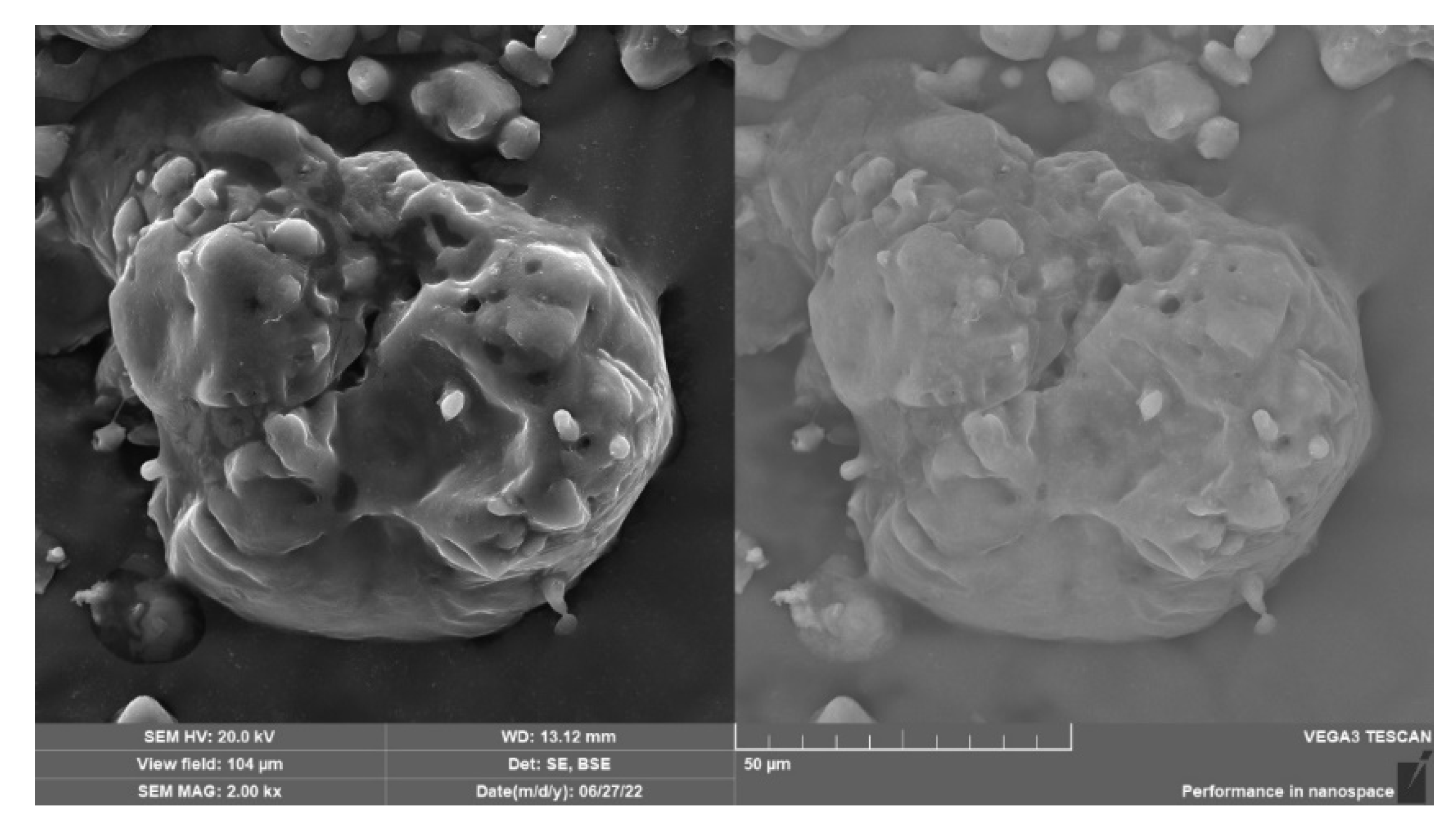
2.2. Test Method and Specimen Preparation
2.3. Experimental Procedure
3. Results and Analysis
3.1. Analysis of XRD Test Results
3.2. MIP Analysis of Test Results
3.3. Analysis of SEM Test and PCAS Test Results
3.4. Analysis of UCS Test Result
4. Conclusions
Author Contributions
Funding
Institutional Review Board Statement
Informed Consent Statement
Data Availability Statement
Conflicts of Interest
References
- Liu, W.; Zhao, F.; Yang, W.; Chen, X. Features and properties of peaty soil in Caohai section of Anning-Sonming line. Chin. J. Geotech. Eng. 2013, 35, 671–674. [Google Scholar]
- Wong, L.; Hashim, R.; Ali, F. Strength and permeability of stabilized peat soil. J. Appl. Sci. 2008, 8, 3986–3990. [Google Scholar] [CrossRef]
- Zhang, S. The Infection on the Humic Acid in the Progress of Solidifying Soft Soil by Cement Soil. Ph.D. Thesis, Jilin University, Jilin, China, 2007. [Google Scholar]
- Young, J. A review of the mechanisms of set-retardation in Portland cement pastes containing organic admixtures. Cem. Concr. Res. 1972, 2, 415–433. [Google Scholar] [CrossRef]
- Zeng, W.; Tang, X.; He, M. Application of cement deep-mixing method in treatment of peat soil. J. Geol. Hazards. Environ. Preserv. 2002, 13, 67–69. [Google Scholar]
- Thompson, M.R. Lime reactivity of Illinois soils. J. Soil. Mech. Found. Div. 1966, 92, 67–92. [Google Scholar] [CrossRef]
- Chen, H. A Study on the Behavior of Organic Matter in the Progress of Solidifying Soft Soil by Cement. Ph.D. Thesis, Jilin University, Jilin, China, 2006. [Google Scholar]
- Liang, S.; Zhou, J.; Luo, Q.; Lin, H. An Experimental Research on the Effect of Organic Matter on Mechanical Properties of Cementing Solidified Silt. J. Guangdong Univ. Technol. 2019, 36, 86–91. [Google Scholar]
- Cao, J.; Song, Y.; Gao, Y. Preliminary experimental study on the corrosiveness of humic group to cement-soil. J. Saf. Environ. 2023, 23, 3098–3106. [Google Scholar]
- Liu, H.; Xu, Z.; Shao, Z. Effect of Organic Matters on Mechanical Properties of Cement Treated Red Clay and its Micro-mechanism. Soil. Eng. Found. 2021, 35, 645. [Google Scholar]
- Mohsen, A.; Kohail, M.; Alharbi, Y.R.; Abadel, A.A.; Soliman, A.M.; Ramadan, M. Bio-mechanical efficacy for slag/fly ash-based geopolymer mingled with mesoporous NiO. Case Stud. Constr. Mater. 2023, 19, e02283. [Google Scholar] [CrossRef]
- Ramadan, M.; Kohail, M.; Abadel, A.A.; Alharbi, Y.R.; Soliman, A.M.; Mohsen, A. Exploration of mechanical performance, porous structure, and self-cleaning behavior for hydrothermally cured sustainable cementitious composites containing de-aluminated metakaolin waste and TiO2 nanoparticles. J. Mater. Res. Technol. 2023, 25, 3998–4019. [Google Scholar] [CrossRef]
- Ramadan, M.; Habib, A.; Kohail, M.; Mohsen, A. Enhancement of fresh and hardened properties of geopolymeric composite containing toxic lead sludge: A comparative study between the effect of superplasticizer and thermal treatment of sludge. J. Build. Eng. 2023, 71, 106482. [Google Scholar] [CrossRef]
- Mohamed, O.; Hazem, M.; Mohsen, A.; Ramadan, M. Impact of microporous γ-Al2O3 on the thermal stability of pre-cast cementitious composite containing glass waste. Constr. Build. Mater. 2023, 378, 131186. [Google Scholar] [CrossRef]
- Ramadan, M.; Kohail, M.; Alharbi, Y.R.; Abadel, A.A.; Binyahya, A.S.; Mohsen, A. Investigation of autoclave curing impact on the mechanical properties, heavy metal stabilization and anti-microbial activity of the green geopolymeric composite based on received/thermally-treated glass polishing sludge. J. Mater. Res. Technol. 2023, 23, 2672–2689. [Google Scholar] [CrossRef]
- Essam, Y.; El-Faramawy, N.; Ramadan, W.; Ramadan, M. From dangerous wastes to green construction materials, as thermally stable-radiation blocker, in presence of meso-porous magnesia and alumina. J. Build. Eng. 2023, 66, 105896. [Google Scholar] [CrossRef]
- Ramadan, M.; Habib, A.; Hazem, M.; Amin, M.; Mohsen, A. Synergetic effects of hydrothermal treatment on the behavior of toxic sludge-modified geopolymer: Immobilization of cerium and lead, textural characteristics, and mechanical efficiency. Constr. Build. Mater. 2023, 367, 130249. [Google Scholar] [CrossRef]
- Wei, R.; Zeng, Y. The relationship between fineness and strength of different varieties of cement. Cem. Eng. (Nanjing, China) 1998, 14–15. [Google Scholar]
- Li, H.J.; Yang, L.; Xie, Y.J. Effect of fineness on the properties of cement paste. Key Eng. Mater. 2015, 629, 366–370. [Google Scholar] [CrossRef]
- Kontoleontos, F.; Tsakiridis, P.; Marinos, A.; Katsiotis, N.; Kaloidas, V.; Katsioti, M. Dry-grinded ultrafine cements hydration. physicochemical and microstructural characterization. Mater. Res. (Sao Carlos Braz.) 2013, 16, 404–416. [Google Scholar] [CrossRef]
- Aiqin, W.; Chengzhi, Z.; Ningsheng, Z. The theoretic analysis of the influence of the particle size distribution of cement system on the property of cement. Cem. Concr. Res. 1999, 29, 1721–1726. [Google Scholar] [CrossRef]
- Chen, J.; Kwan, A. Superfine cement for improving packing density, rheology and strength of cement paste. Cem. Concr. Compos. 2012, 34, 1–10. [Google Scholar] [CrossRef]
- Arteaga-Arcos, J.C.; Chimal-Valencia, O.A.; Yee-Madeira, H.T.; De La Torre, S.D. The usage of ultra-fine cement as an admixture to increase the compressive strength of Portland cement mortars. Constr. Build. Mater. 2013, 42, 152–160. [Google Scholar] [CrossRef]
- Liu, X.; Wu, J. Study on the properties of curing agent material for soft soil with high water content. J. Hunan Univ. Arts Sci. Nat. Sci. Ed. 2019, 31, 85–89+94. [Google Scholar]
- Valcuende, M.; Parra, C.; Marco, E.; Garrido, A.; Martínez, E.; Cánoves, J. Influence of limestone filler and viscosity-modifying admixture on the porous structure of self-compacting concrete. Constr. Build. Mate. 2012, 28, 122–128. [Google Scholar] [CrossRef]
- Shao, Y. Study on Humus-Containning Soil Stabilization. Ph.D. Thesis, Zhejiang University, Zhejiang, China, 2006. [Google Scholar]
- Song, Y.; Cao, J.; Ding, W.; Song, Z.; Liu, H.; Huang, S.; Zhu, W. Influence of Peat Soil Environment on Mechanical Properties of Cement-Soil and Its Mechanism. Sustainability 2023, 15, 4580. [Google Scholar] [CrossRef]
- Wetwet, M.M.; El-Gamal, S.; Ramadan, M.; Hazem, M. Multifunctional cementitious blends containing zirconia nanoparticles: Mechanical characteristics, gamma attenuation behavior, and self-cleaning performance. J. Build. Eng. 2023, 65, 105736. [Google Scholar] [CrossRef]
- Sayed, D.; El-Hosiny, F.; El-Gamal, S.; Hazem, M.; Ramadan, M. Synergetic impacts of mesoporous α-Fe2O3 nanoparticles on the performance of alkali-activated slag against fire, gamma rays, and some microorganisms. J. Build. Eng. 2022, 57, 104947. [Google Scholar] [CrossRef]
- Cao, J.; Sun, H.; Huang, S.; Kong, C.; Liu, F.; Tian, L.; Zhu, W. Influence of ultrafine cement on cement-soil in peat soil environment of Dianchi Lake. J. Civ. Environ. Eng. 2023. [Google Scholar]
- GB/T 50123-2019; Standard for Geotechnical Testing Method. Ministry of Water Resources of the People’s Republic of China. China Planning Press: Beijing, China, 2019.
- Abo-El-Enein, S.; El-Hosiny, F.; El-Gamal, S.; Amin, M.; Ramadan, D.M. Gamma radiation shielding, fire resistance and physicochemical characteristics of Portland cement pastes modified with synthesized Fe2O3 and ZnO nanoparticles. Constr. Build. Mater. 2018, 173, 687–706. [Google Scholar] [CrossRef]
- Ramadan, M.; Amin, M.; Sayed, M.A. Superior physico-mechanical, fire resistivity, morphological characteristics and gamma radiation shielding of hardened OPC pastes incorporating ZnFe2O4 spinel nanoparticles. Constr. Build. Mater. 2020, 234, 117807. [Google Scholar] [CrossRef]
- Ramadan, M.; El-Gamal, S.; Selim, F. Mechanical properties, radiation mitigation and fire resistance of OPC-recycled glass powder composites containing nanoparticles. Constr. Build. Mater. 2020, 251, 118703. [Google Scholar] [CrossRef]
- Chen, Y.; Zhong, H.; Yin, W.; Yao, G. Effect of Calcium–Silicon Ratio of Calcium Silicate Hydrate on Its Structure, Zeta Potential and Adsorption Capacity of Superplasticizer. Bull. Chin. Ceram. Soc. 2020, 39, 1798–1804. [Google Scholar]
- Li, L.; Han, Q.; Yang, X.; Xiao, H.; Li, W.; Huang, S. Mechanical properties and micro-mechanisms of RHA-cement solidified sludge. China. Civ. Eng. J. 2022. [Google Scholar] [CrossRef]
- Lei, Y.; Han, T.; Wang, H.; Jin, X.; Yang, F.; Cao, H.; Cheng, F. Preparation and Characterization of Calcium Silicate Hydrate(C-S-H) Synthesized by the Hydrothermal Method. Bull. Chin. Ceram. Soc. 2014, 33, 465–469. [Google Scholar]
- Cao, J.; Liu, F.; Huang, S.; Liu, H.; Song, Z.; Li, J.; Liu, G. Effect of UFC on the Microscopic Pore Structure of Cemented Soil in Humic Acid Environment. Sustainability 2023, 15, 3241. [Google Scholar] [CrossRef]
- Huang, X.; Zhou, G. Harding Mechanism of Cement-Stablized Soil. Chin. J. Geotech. Eng. 1994, 16, 62–68. [Google Scholar]
- Xun, Y. Test on strengthening soft soil with cementatory solidifying agent containing industrial waste. Chin. J. Geotech. Eng. 2000, 22, 210–213. [Google Scholar]



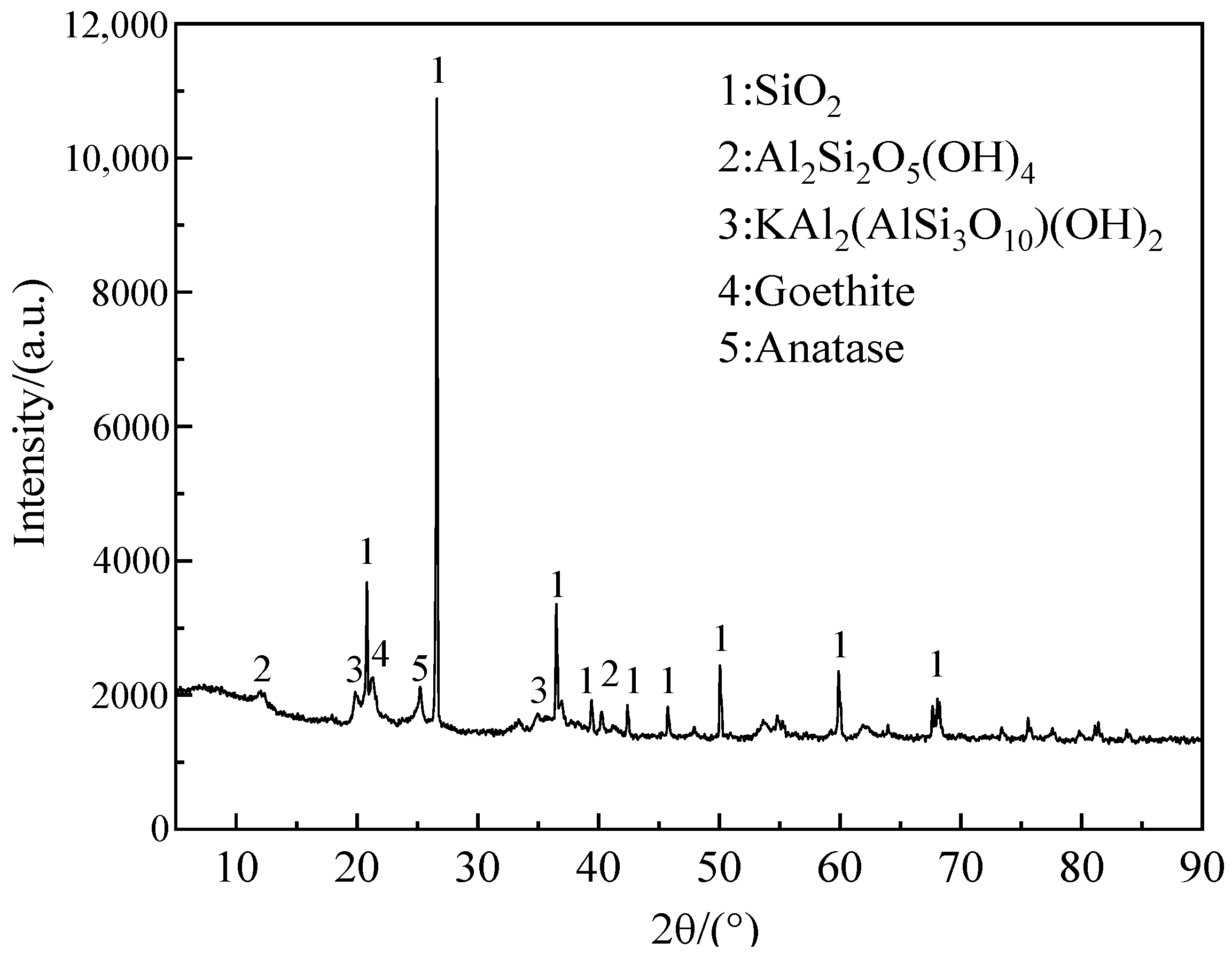
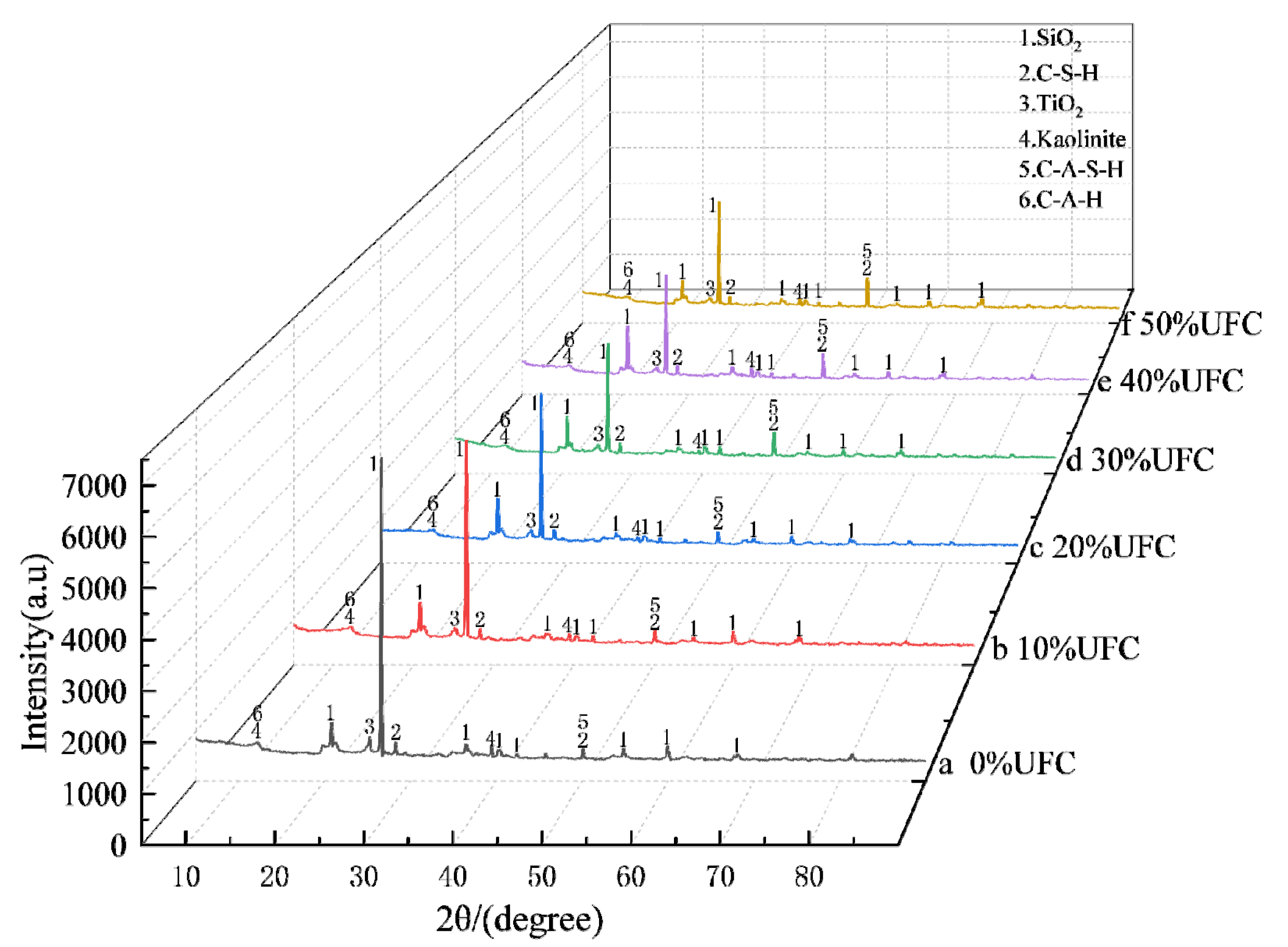
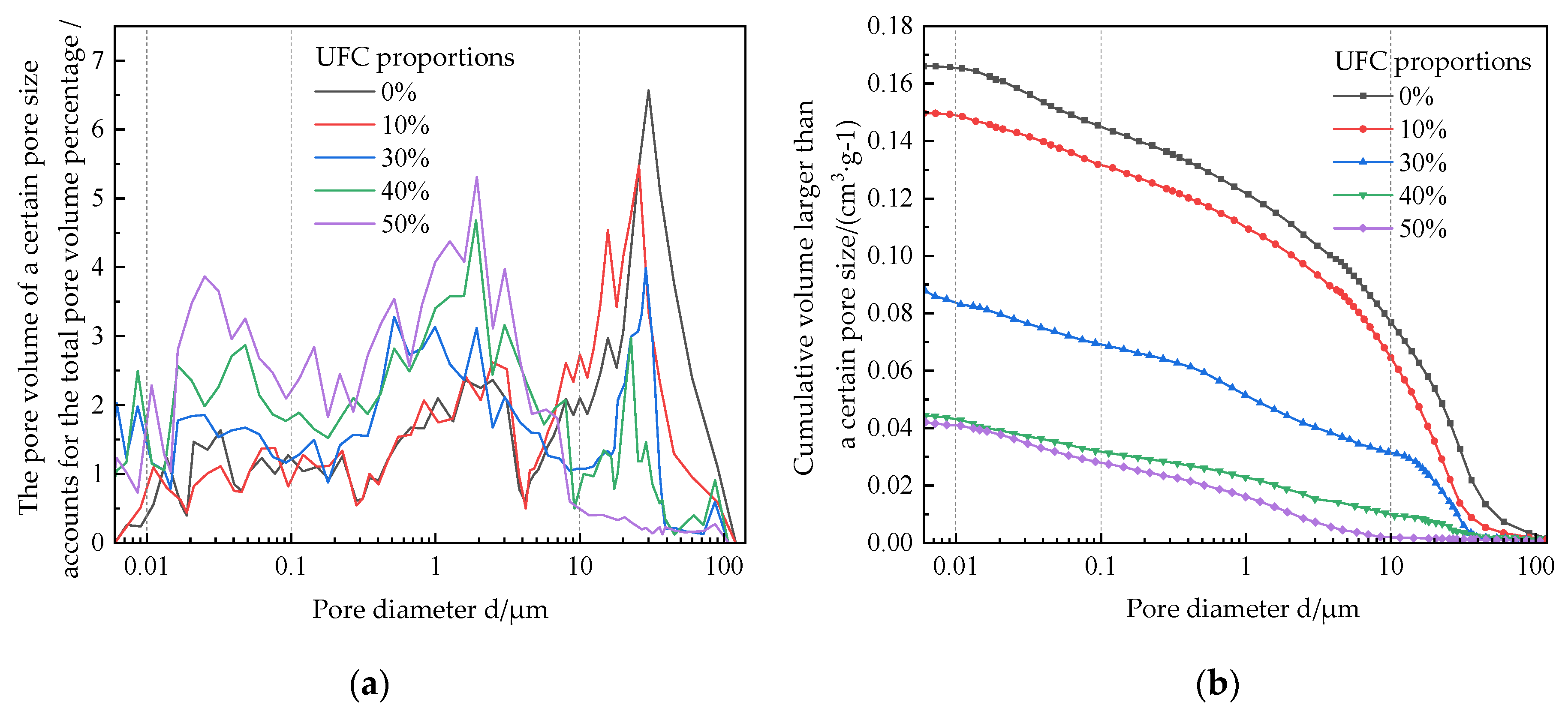

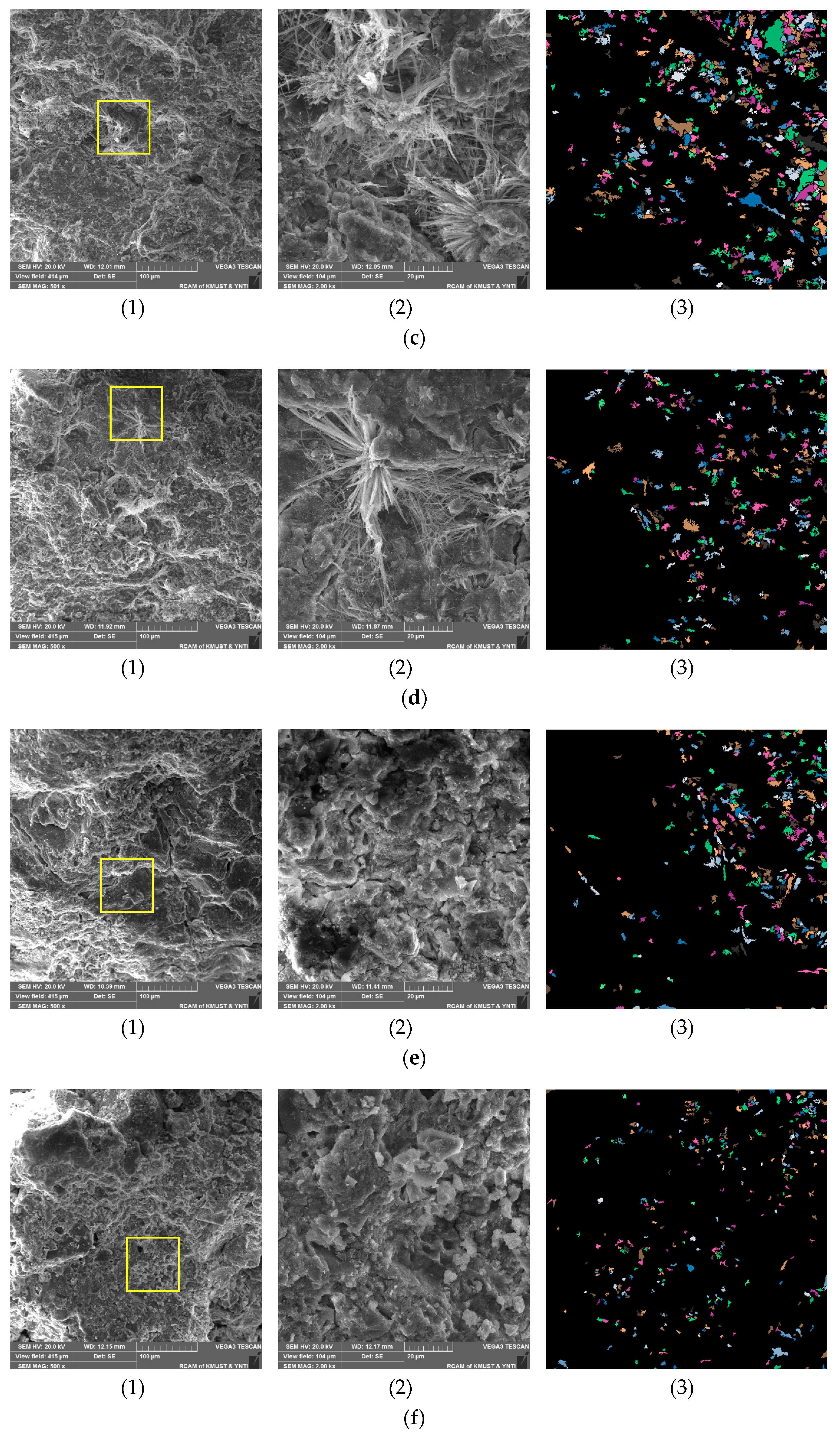
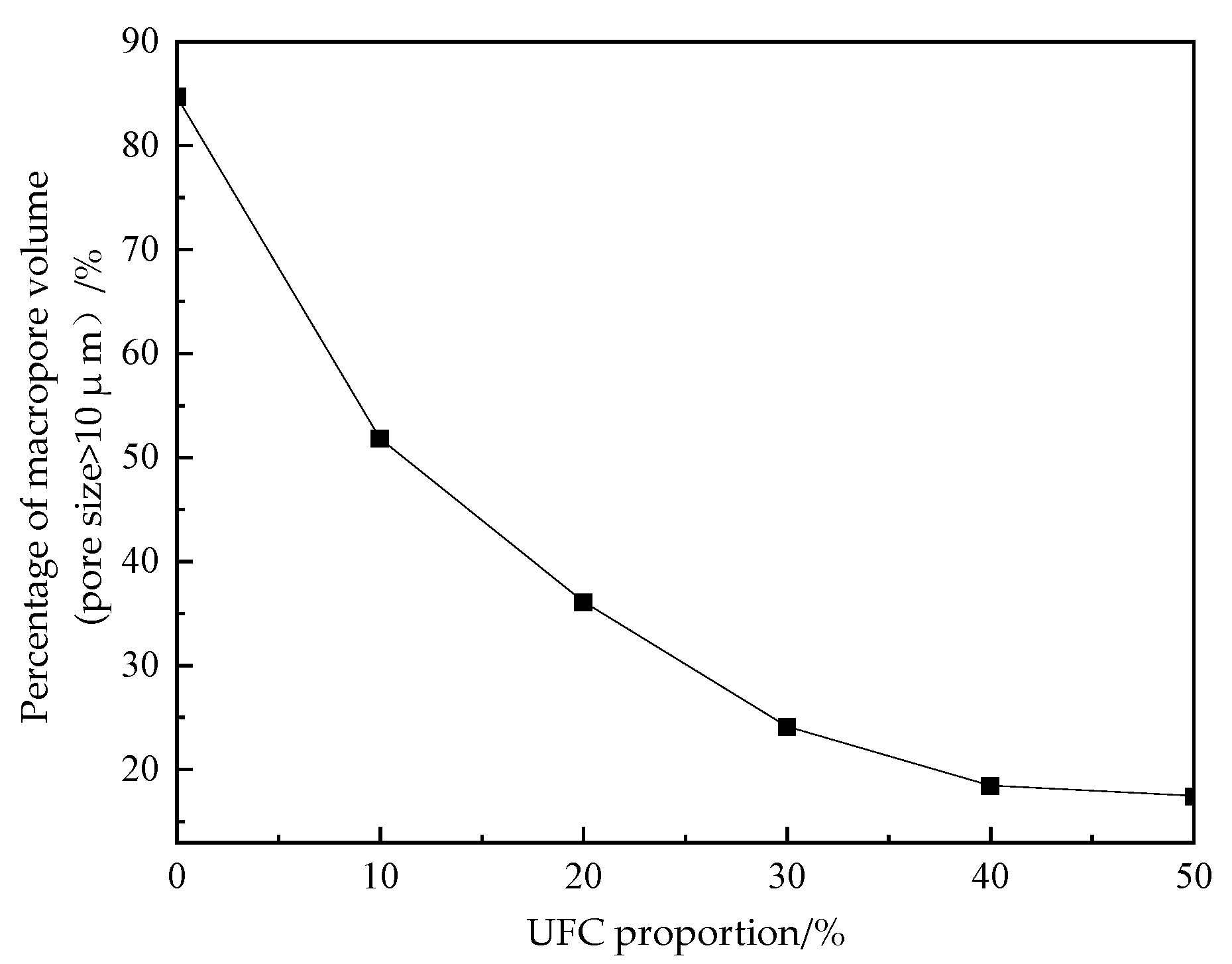
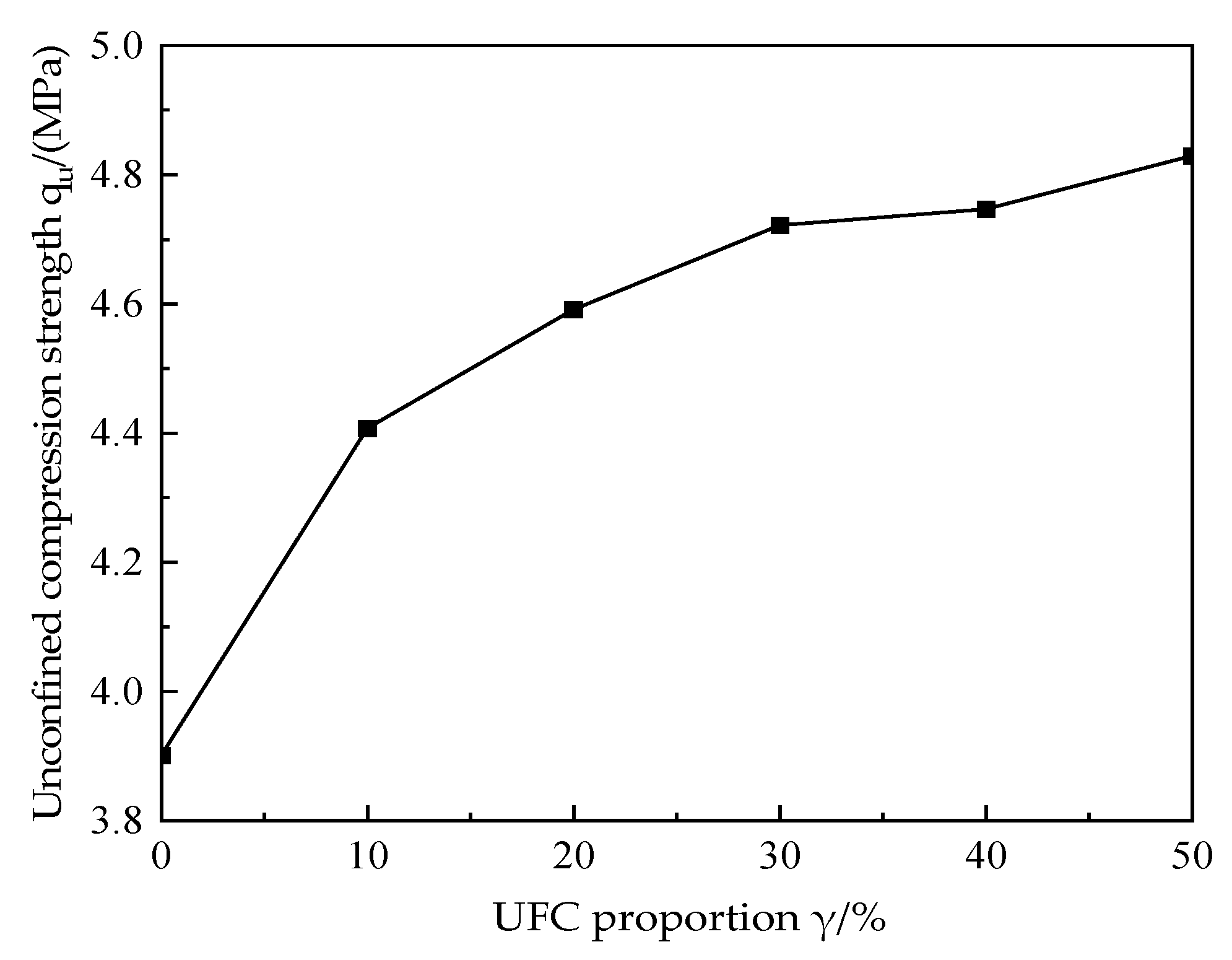
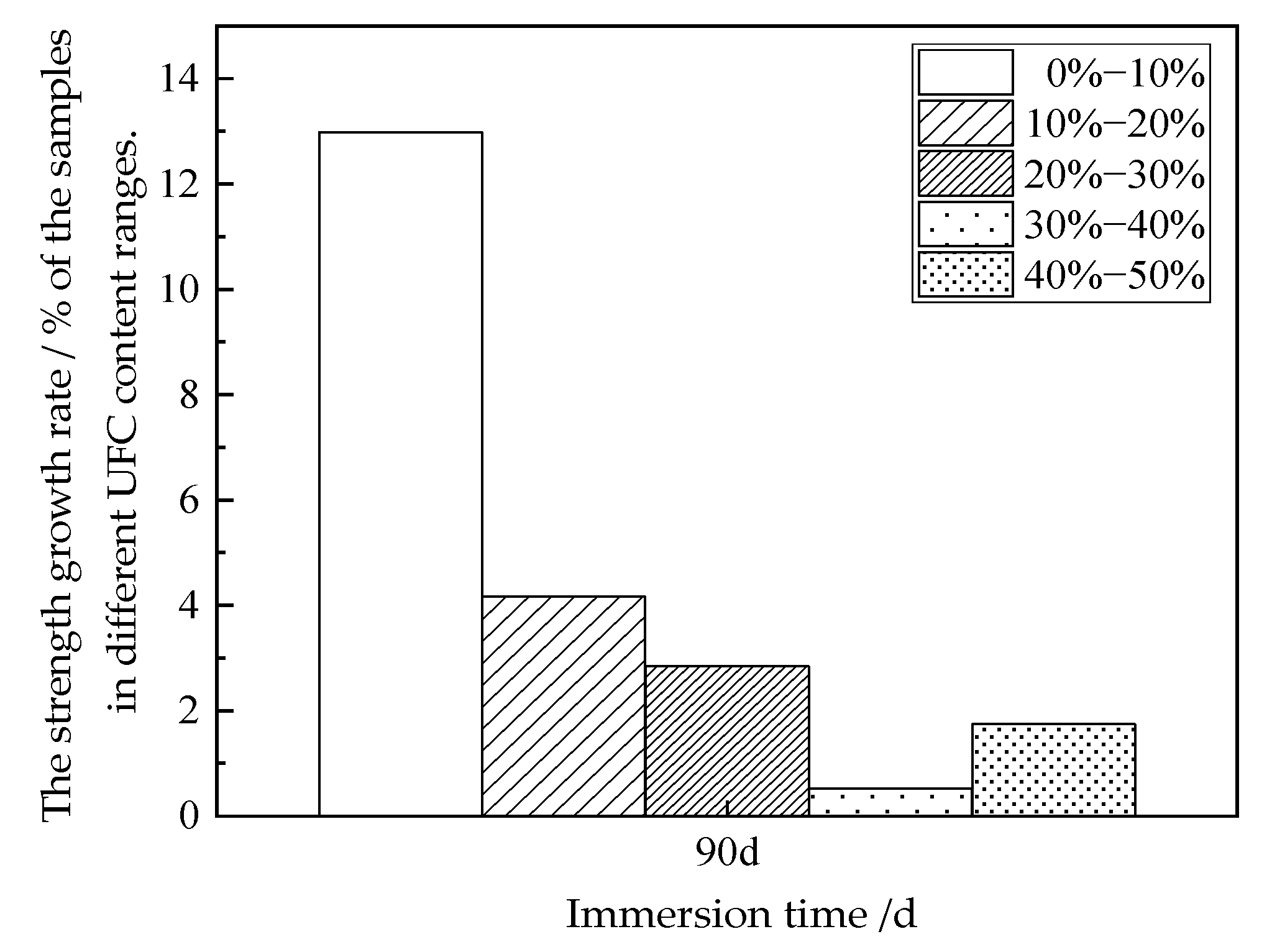
| Test Soil | Chemical Composition and Their Contents (%) | ||||||||||
|---|---|---|---|---|---|---|---|---|---|---|---|
| SiO2 | Fe2O3 | Al2O3 | TiO2 | K2O | MgO | CaO | Na2O | MnO | P2O5 | Ignition Loss | |
| Cohesive soil | 46.57 | 21.22 | 20.8 | 8.9 | 0.48 | 0.48 | 0.16 | 0.04 | 0.14 | 0.57 | 0.64 |
| Material Type | D95/µm | Maximum Particle Size/µm | Blaine Area/(cm2/g) | Color |
|---|---|---|---|---|
| OPC | 77.16 | 138.04 | 7880 | Grey |
| UFC | 8.23 | 11.83 | 10,703 | Grey |
| Cohesive soil | 673.57 | 2187.7 | / | Brownish yellow |
| HA | 261.38 | 478.63 | / | Black |
| Material Category | Chemical Composition and Their Mass Fraction (%) | |||||||
|---|---|---|---|---|---|---|---|---|
| CaO | SiO2 | Al2O3 | MgO | Fe2O3 | Na2O | K2O | Other | |
| OPC | 65.5 | 18.4 | 5.3 | 3.9 | 2.9 | 0.5 | 0.3 | 3.2 |
| UFC | 65.5 | 18 | 5.4 | 3.8 | 2.9 | 0.5 | 0.3 | 3.6 |
| Test Method | Cement Mixing Ratio β/% | UFC Proportion γ/% | HA Content λ/% | Moisture Content ω/% | Porosity Ratio /e | Soaking Liquid Category | Soaking Time /d |
|---|---|---|---|---|---|---|---|
| XRD, MIP, SEM, PCAS, UCS | 20 | 0 | 15 | 24 | 1.2 | FA solution (pH = 6.0) | 90 d |
| 10 | |||||||
| 20 | |||||||
| 30 | |||||||
| 40 | |||||||
| 50 |
| XRD, MIP, SEM, and PCAS Comparison | |
|---|---|
| XRD test | The XRD patterns indicate the presence of hydration products, reflecting the many phases in the cement soil. |
| MIP test | The MIP test shows the change in the internal structure of the pores of the cement soil. With the increase in the UFC proportion, the macropores are transformed into small and medium pores, the cumulative pore volume percentage of large pores decreases, and the cumulative pore volume percentage of small and medium pores increases. |
| SEM test | The SEM test presents the number and morphological changes of hydration products and the changing forms of pores. As the UFC proportion increases, the number of hydration products increases and the lap hydration products are gradually ordered and flat. Fibrous hydration products gradually lap into massive hydration products—the pore space changes from visible to almost invisible. |
| PCAS test | The PCAS test demonstrates the connectivity of the internal pores’ structure. With the increase in the UFC proportion, the internal structure of cement soil gradually changes from large-area connectivity to small-area connectivity. Finally, it shows that the pores are not connected. |
Disclaimer/Publisher’s Note: The statements, opinions and data contained in all publications are solely those of the individual author(s) and contributor(s) and not of MDPI and/or the editor(s). MDPI and/or the editor(s) disclaim responsibility for any injury to people or property resulting from any ideas, methods, instructions or products referred to in the content. |
© 2023 by the authors. Licensee MDPI, Basel, Switzerland. This article is an open access article distributed under the terms and conditions of the Creative Commons Attribution (CC BY) license (https://creativecommons.org/licenses/by/4.0/).
Share and Cite
Cao, J.; Huang, C.; Sun, H.; Guo, Y.; Ding, W.; Hua, G. Analysis of the Effect of Ultra-Fine Cement on the Microscopic Pore Structure of Cement Soil in a Peat Soil Environment. Appl. Sci. 2023, 13, 12700. https://doi.org/10.3390/app132312700
Cao J, Huang C, Sun H, Guo Y, Ding W, Hua G. Analysis of the Effect of Ultra-Fine Cement on the Microscopic Pore Structure of Cement Soil in a Peat Soil Environment. Applied Sciences. 2023; 13(23):12700. https://doi.org/10.3390/app132312700
Chicago/Turabian StyleCao, Jing, Chenhui Huang, Huafeng Sun, Yongfa Guo, Wenyun Ding, and Guofeng Hua. 2023. "Analysis of the Effect of Ultra-Fine Cement on the Microscopic Pore Structure of Cement Soil in a Peat Soil Environment" Applied Sciences 13, no. 23: 12700. https://doi.org/10.3390/app132312700
APA StyleCao, J., Huang, C., Sun, H., Guo, Y., Ding, W., & Hua, G. (2023). Analysis of the Effect of Ultra-Fine Cement on the Microscopic Pore Structure of Cement Soil in a Peat Soil Environment. Applied Sciences, 13(23), 12700. https://doi.org/10.3390/app132312700






